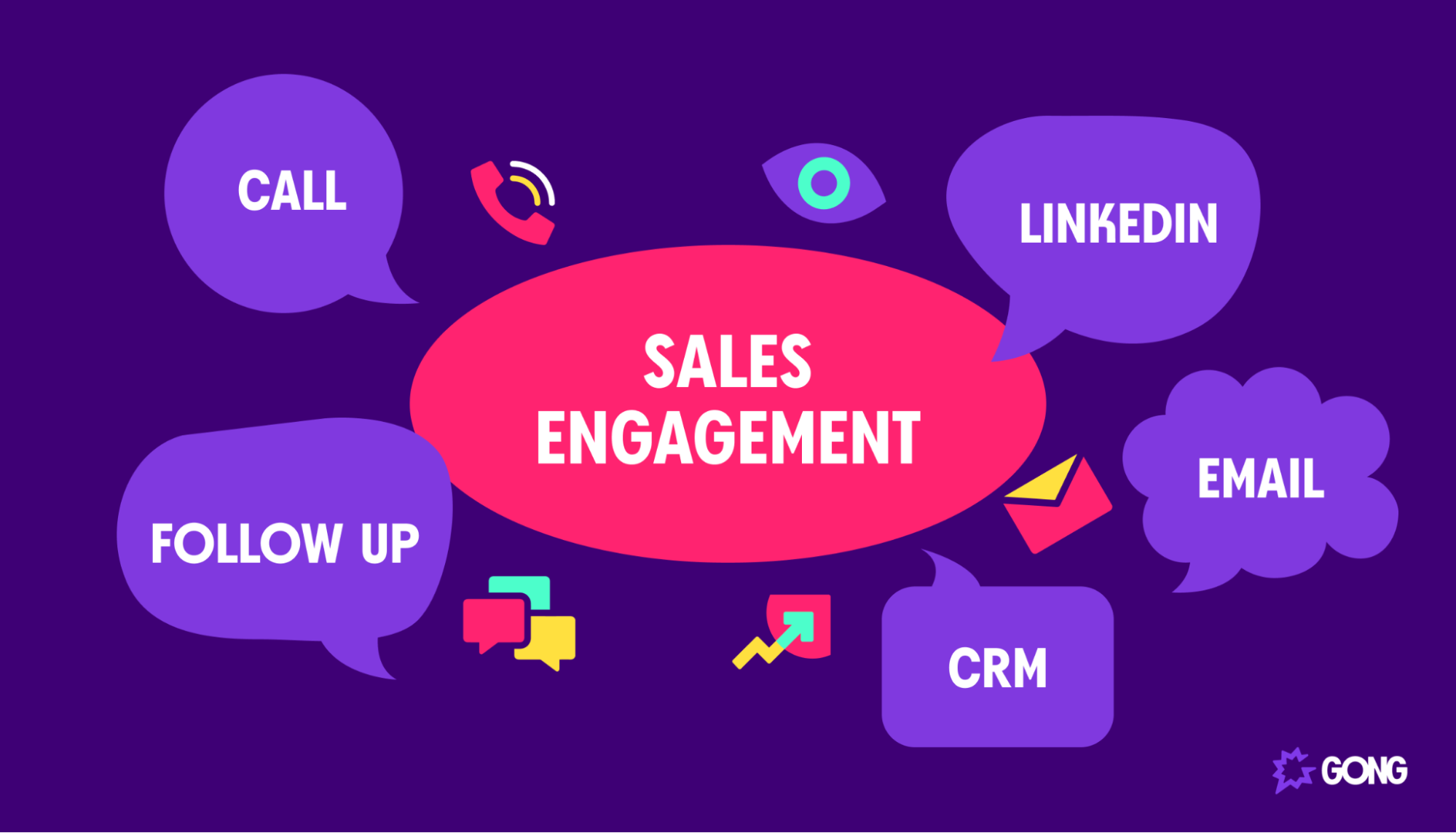How to Make the Most Out of Your Sales Engagement Platform

In today’s rapidly evolving sales landscape, the integration of sales engagement platforms have become essential for businesses.
These platforms offer a variety of features and functionalities designed to streamline sales processes, enhance customer interactions, and boost overall productivity.
However, simply having access to these tools is not enough; knowing how to leverage them effectively is the key to maximizing their potential.
In this blog, we’ll dive into essential strategies and tips to help you harness the full power of your sales engagement platform, empowering you to closer more deals and achieve unparalleled success in the competitive world of sales.
What are sales engagement platforms?
Picture a control center where data-driven insights fuse seamlessly with personalized buyer interactions. Sales engagement platforms act as a hub, unifying tailored communication, prospect engagement, and strategic analytics. AI-powered tools empower sales reps to customize pitches, identify high-potential leads, and seal deals more efficiently.
Sales teams can gain real-time visibility into the sales pipeline, transforming intricate data into actionable intelligence. This enables agile resource allocation and data-driven strategy shifts. Simultaneously, marketing experts align their efforts through integrated automation, lead scoring, and precise segmentation.
This platform’s value goes beyond operational excellence. It becomes a repository of sales wisdom, capturing successful tactics and objections and ensuring consistent performance amid team transitions.
Exploring the strategic advantages of sales engagement platforms
In this section, we’ll dive into the benefits of sales engagement platforms that can work wonders for your sales team’s performance, process streamlining, and revenue amplification. The perks sales engagement software can provide include:
- Multichannel communication: Sales engagement platforms enable effortless outreach through various channels, helping your team connect with prospects in their preferred ways. This flexibility boosts engagement and nurtures buyer relationships.
- Personalized outreach: Sales engagement software crafts custom messages that deeply connect with prospects. This approach grabs attention, building genuine interest and connections.
- Data-driven insights: Platforms analyze prospect behavior, interactions, and engagement for actionable insights. With data-driven decisions, your team adapts in real-time, driving higher conversion rates.
- Workflow automation: Farewell to repetitive tasks. Platforms automate the sales process — like follow-ups and scheduling — for consistency and efficiency. Errors decrease, and team focus shifts to relationships.
- CRM integration: CRM integration defines sales engagement platforms. It centralizes interactions, notes, and data for a comprehensive prospect view, fostering efficient collaboration.
- Collaboration and knowledge sharing: Sales thrives on teamwork, and these platforms foster collaboration. Virtual hubs enable sharing strategies, insights, and updates, speeding up learning for newcomers and nurturing a culture of improvement.
- Lead prioritization: Platforms use algorithms to score based on engagement and fit, prioritizing high-conversion potential leads for your team.
- Content management: Easy access to content boosts competitiveness. Platforms store collateral, presentations, and docs for quick sharing. Sales teams have apt content for every sales stage.
- Enhanced efficiency: Sales platforms boost efficiency, enabling peak performance. Automation and data-driven guidance save time, reducing the amount of repetitive tasks.
How to evaluate your current sales engagement platform
In the dynamic world of modern sales, success goes beyond adopting cutting-edge tools; it demands a strategic approach to their ongoing effectiveness. This rings particularly true for sales engagement platforms. While their initial implementation is vital, the journey doesn’t stop there. Regularly evaluating your sales engagement software guides your sales team towards lasting triumph and heightened ROI.
Define evaluation criteria
Establish clear evaluation criteria that serve as the benchmark for measuring your sales engagement platform’s performance. These parameters create a structured analysis framework aligned with your organization’s goals.
- Tailor KPIs to conversion rates, revenue growth, acquisition costs, and buyer lifetime value, pivotal for executive decisions.
- Examine lead response time, lead-to-opportunity conversion, and sales cycle length metrics for the sales process, cost-effectiveness, and buyer satisfaction.
- Analyze shared resource usage, engagement, and collaboration ease for teamwork and leveraging knowledge.
- Use open rates, click-through rates, and feedback metrics to assess platform effectiveness in engaging prospects and fostering connections.
- Utilize deal closure rate, average deal size, and pipeline value metrics to link platform performance directly to revenue and bottom-line impact.
Assess user adoption
Evaluating your sales engagement platform involves assessing user adoption to understand how well your sales team has integrated the platform into their routines and its impact on their overall performance.
- Examine how frequently the platform is accessed, usage of key features, and engagement with functionalities to grasp its value proposition.
- The enthusiastic endorsement from your sales team is crucial for successful implementation, reflecting alignment with needs and values.
- Address Implementation Challenges: Identify potential hurdles, like resistance to change or learning curve, and take proactive steps to overcome them.
- Implement Mitigation Strategies: Enhance user adoption through comprehensive training, transparent communication, ongoing support, and incorporating user feedback for platform refinement.
Measure impact on sales performance
Analyzing the platform’s influence on lead conversions, deal velocity, and revenue growth provides a holistic perspective that guides enhanced sales performance through informed decision-making and strategic improvements.
- Examine data to quantify the platform’s role in driving these key sales outcomes.
- Demonstrate a clear link between specific platform features and their direct influence on measurable sales results.
- Showcase how these key features enhance lead conversion rates, expedite deal progression, and ultimately foster revenue expansion.
Evaluate integration and scalability
Evaluating integration and scalability ensures that your sales engagement platform harmonizes with your existing technology and is equipped to evolve alongside your growing operations. This assessment guarantees a seamless technological landscape that supports your sales team’s efficiency and lays a strong foundation for future expansion.
- Evaluate the platform’s seamless integration with the existing tech stack, including CRM systems.
- Discuss its scalability to accommodate growing sales operations without diminishing efficiency.
Assess user-friendliness and adoption
Assessing user-friendliness and adoption ensures alignment with user needs, sales productivity, and success.
- Test platform navigation, feature access, and task performance with users. Gather insights on challenges faced during interactions.
- Collect sales team feedback via surveys, interviews, or forms. Gain insights into experience, pain points, and improvement suggestions.
- Use tools to monitor user behavior. Track time on features, click-through rates, and task completion for engagement insights.
- Compare the platform’s user-friendliness to industry norms. Identify strengths and areas needing enhancement.
Analyze data and insights
Analyzing platform data ensures accurate insights. It guides decisions, refines tactics, and fosters growth.
- Assess the accuracy, completeness, and relevance of the data collected by the platform. Ensure that the data is reliable and reflects actual sales interactions.
- Dive into the depth of the analytics offered by the platform. Explore metrics such as engagement rates, buyer interactions, lead progression, and deal performance.
- Compare historical data with current insights. Look for trends, patterns, and anomalies that can comprehensively understand sales activities.
Gather feedback from sales team
Sales team feedback directly enhances platform usability and alignment. Collaboration between users and developers leads to improved sales outcomes.
- Conduct structured feedback sessions, such as surveys or focused interviews, to elicit input from sales representatives.
- Pose open-ended questions that encourage detailed responses. Inquire about their experiences, challenges, and areas where they see room for improvement.
- Prompt them to highlight the strengths they’ve observed in the platform and any weaknesses or pain points they’ve encountered.
- Encourage them to provide suggestions for improvement, whether related to usability, features, or integration with their workflow.
Identify gaps and challenges
Spotting platform gaps is proactive. It aligns with needs, empowers decisions, and bolsters market standing.
- Map out the user journey within the platform. Identify points where users encounter difficulties or where the process seems less efficient.
- Compare the platform’s capabilities to industry benchmarks or competitors’ offerings. This comparison highlights areas where your platform may need to catch up.
- Analyze user feedback, including sales team members and executives, regarding any issues they’ve faced or features they find lacking.
Compare with strategic goals
Comparing the platform with goals turns it into a strategic enabler. It drives impactful decisions and resource use, advancing the organization’s vision.
- Review your organization’s sales and revenue objectives. Understand the broader goals the platform should contribute to.
- Evaluate how the platform’s current performance aligns with these strategic objectives. Measure its impact on sales, revenue growth, and other vital goals.
- Identify any gaps between the platform’s capabilities and your strategic goals. Assess whether the platform supports the execution of high-level strategies effectively.
Consider industry trends
Industry trend consideration is crucial for platform competitiveness, relevance, and innovation. It ensures your platform aligns with industry shifts, empowering your sales team for market excellence.
- Stay informed about the latest trends, technologies, and best practices in sales engagement through industry reports, articles, and conferences.
- Evaluate how the platform’s features align with the emerging trends in sales engagement. Compare its capabilities with the innovative solutions gaining traction in the industry.
- Assess whether the platform can adapt and integrate new trends. Ensure it remains relevant as the industry evolves.
Make the decision to transition
Based on the evaluation, determine whether adjustments, improvements, or a transition to a new platform are necessary.
- Analyze the data and insights collected during the evaluation process. Identify areas of strength, weakness, and gaps in alignment with goals.
- Consider whether adjustments or improvements to the current platform can address identified issues. Determine if these adjustments are feasible and sufficient.
- If substantial gaps or limitations persist, evaluate the need to transition to a new platform. Explore available options and assess how they align with your organization’s needs.
Choosing the best sales engagement platform for your team
Selecting a suitable sales engagement platform transcends operational decisions; it becomes a strategic imperative for sales teams. The choice of platform has the potential to shape an organization’s success, influencing strategic decision-making, enhancing operational efficiency, and driving revenue growth.
Understand strategic requirements
- Discuss the importance of aligning platform features with overarching business goals.
- Encourage executives to identify specific functionalities needed to drive high-level strategies.
Create a feature checklist
- Provide a structured checklist of essential features and capabilities.
- Include seamless CRM integration, analytics, automation, and scalability.
Customization and personalization
- Stress the significance of platforms that allow tailored buyer interactions.
- Highlight the benefits of personalized outreach in building strong client relationships.
Scalability and adaptability
- Discuss the need for a platform to accommodate current and future sales operations.
- Explain how scalability ensures long-term efficiency and growth potential.
Explore integration with existing tools
- Explore the importance of integration with other tools in the tech stack.
- Illustrate how data flow and collaboration can be enhanced through seamless integration.
User-friendly interface
- Discuss the impact of user-friendliness on swift adoption and reduced learning curves.
- Explain how an intuitive interface contributes to increased team productivity.
Analytical power
- Highlight the value of robust analytics and reporting features.
- Show how data-driven insights guide strategic decision-making and refine sales strategies.
Vendor support and training
- Stress the importance of comprehensive onboarding and training resources.
- Discuss the significance of responsive customer support in addressing potential challenges.
Consider future trends
- Encourage executives to consider industry trends and the platform’s adaptability to changes.
- Discuss the advantages of platforms that evolve in tandem with the sales landscape.
Cost vs. value analysis
- Address the balance between cost and the value the platform brings.
- Guide executives to prioritize value regarding efficiency, productivity, and revenue potential.
Piloting and testing
- Suggest piloting a shortlist of platforms to gauge their real-world effectiveness.
- Highlight the importance of feedback from sales reps during the testing phase.
Final decision and implementation
- Provide insights into the decision-making process and implementation timeline.
- Emphasize the need for a smooth transition and alignment with sales strategies.
See Gong’s sales engagement platform in action
Sales engagement tools bridge the gap between sales reps and closed deals, revolutionizing how interactions are managed.
Intrigued by the prospect of boosting your sales team’s efficiency and effectiveness? Learn more by getting a demo with a product expert and see how Gong’s engagement platform can equip your sales team for success.



